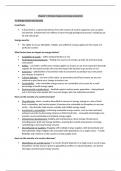Notas de lectura
Class Notes IB ESS Unit 7
- Grado
- Institución
- Book
Class notes on IB ESS Unit 7: Climate Change and Energy Production. Detailed explanations and examples needed for the exam and for writing comprehensive essays. Evaluations made about different types of renewable and non-renewable methods of energy production. Highly relevant topic of climate chang...
[Mostrar más]



